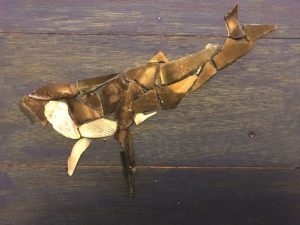I was born in Harrisburg, Pa. and grew up there around the middle of the last century. In my young life, I observed the adults around me: the women were mainly homemakers, some teachers, librarians, and nurses; the men, mostly businessfolk and tradesmen, a few doctors, lawyers, and other professionals.
Never in those years did I meet a single artist. There was art around, I suppose, in magazines, in museums, and in some people’s homes (although I can’t remember ever seeing any original art), but I never saw anybody who actually made art. Art was sort of like avocados — slightly exotic.

I was in my early twenties when I landed in Provincetown, and suddenly I was surrounded by artists — lots of them. Of course, there were plenty of poseurs, those who liked the idea of being an artist, or the look of being an artist; and there were those who earnestly tried to be artists but lacked the nerve and discipline, not to mention talent, and eventually failed in their attempts. But there was also a solid core of people who seriously and professionally pursued the making of art; it was their life’s journey. The famous Cape Cod light has inspired artists of all kinds. And artists, like all humans, seek community (with a touch of isolation). So here they are.
I am fascinated by the person who sees a blank canvas or a block of wood and is motivated — even compelled — to create something where nothing existed before. I have always wondered where that impulse originates. But trying to explain the source of art in a few hundred words seems like a fool’s errand. Scholarly books on the subject bow the shelves of libraries worldwide. Certainly, bands of early humans sat in awe gazing at the starry night sky, or watched in amazement at herds of grazing animals in the meadows, and one in a thousand was moved to recreate these scenes on a cave wall. One of them carved a fertility fetish — ample breasts and large flanks — out of stone.
Doesn’t every child sketch and color at some point, and weren’t most of us exposed to some formal art experience (usually mediocre) in our education? What happens to make a small number of people believe that they can actually create art?
I decided there was no better way to get at the crux of this question than to go to the source. I went to friends, relations, and acquaintances who are artists and asked at what age they realized they were artists and what their primary influences were.
Susan Lyman’s first influence was fashion. She made paper dolls and dresses at age seven or eight and worked on all the prom decorations and her high school yearbook; her later influences were Pop Art and psychedelic album covers. For Don Beal, it was copying from Mad magazine and comic books at seven or eight, but ultimately it was a visit to the Museum of Fine Arts in Boston, where an Andrew Wyeth exhibit transfixed him: “They had to get me out of there. I kept touching the paintings; they were magic portals.” For him, being an artist was “inevitable.”
For Bill Evaul, it was the Philadelphia Museum of Art at age five and a huge Picasso (Three Musicians): “They couldn’t pull me away.”
Jerome Greene’s first success, at age 10, was a portrait of old Zachary Taylor; time spent at the New Britain Museum of Art was formative. Rob Longley says, “The impulse was always there,” but a Monet exhibit at the MFA and, later, a print of Durer’s impressed him.
Richard Pepitone began his creative life finger-painting in a Brooklyn kindergarten and “not even knowing the name of an artist” until his teens. Frank Milby started at about age 10; he remembers successfully drawing an ear of corn. Although his parents were not supportive, he had an art teacher who recognized his talent.
Katrina Walker was a “late starter,” and it was Provincetown’s art scene that “just rubbed off” on her. For Barbara Cohen, “There were no other options. It was in my DNA. I always saw things differently.” My granddaughter, Miranda Dziedzic, age 12, is a serious artist and claims as her influences her time in Provincetown, the Philadelphia Museum of Art, and the art in her household (her parents collect a bit).
If there is a common core in these stories, beyond the importance of museums and a supportive family or community, I can’t find it. The great mystery of the self — of who we are and what we turn out to be, is a Gordian knot: some of us are gay, some straight; some are afraid of heights, some of spiders; some of us are obsessed with sailing, or gardening, or birding, or redheads.
Art blossoms on its own, in receptive minds. Best to leave it at that. And be grateful.



